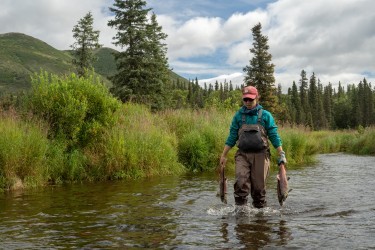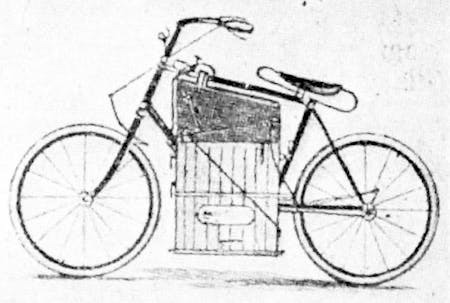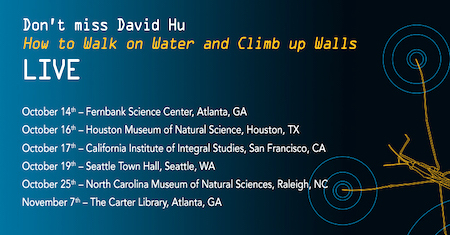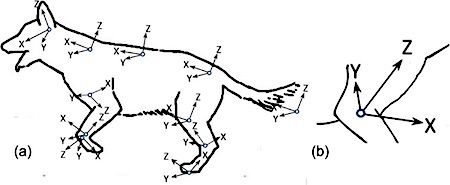Marc Abrahams's Blog, page 168
October 26, 2018
A look back at George Goble’s prize-winning barbecue quick-ignition triumph
A look back (a news report, on Oct 9,1996, via the Wayback Machine) at the Ig Nobel Prize for fastest way to ignite a barbecue.
(An additional, until-now untold aspect of the story: The university’s administration was proud of this, then years later suddenly decided to be frightened of mentioning it, then eventually became again proud of it. University administrators, some of them, can be remarkably timid creatures.)

Here’s video of George Goble doing that R&D work:

October 25, 2018
Dead salmon, again in the service of science
Just a few years after dead salmon helped neuroscientists analyze data more carefully, other dead salmon are helping other scientists better understand how trees grow.
The neuroscience salmon figured in the Ig Nobel Prize-winning study “Neural correlates of interspecies perspective taking in the post-mortem Atlantic Salmon: An argument for multiple comparisons correction,” Craig M. Bennett, Abigail A. Baird, Michael B. Miller, and George L. Wolford, poster, 15th Annual Meeting of the Organization for Human Brain Mapping, San Francisco, CA, June 2009.
The tree-growth salmon were flung mostly to one side of a stream—and mostly not flung to the other side—over a period of twenty years. The salmon carcasses apparently made excellent fodder for the trees that grew on the salmon-carcass laden side of the stream.
The University of Washington News explains:
Sockeye carcasses tossed on shore over two decades spur tree growth
… After counting a dead fish, researchers throw it on shore to remove the carcass and not double-count it the next day. The data collection is part of a long-term study looking at how bear predation affects sockeye salmon in this region.
When this effort began in the mid-1990s, Tom Quinn, a professor in the UW School of Aquatic and Fishery Sciences, decided that everyone should throw sockeye carcasses to the left side of the stream — facing downstream. They might as well be consistent, he thought, and who knows — maybe someday they could see whether the tossed carcasses had an effect on that side of the stream.
Twenty years later, Quinn and colleagues have found that two decades of carcasses — nearly 600,000 pounds of fish — tossed to the left side of Hansen Creek did have a noticeable effect: White spruce trees on that side of the stream grew faster than their counterparts on the other side…. Essentially, as they report in a paper published October 23 in the journal Ecology, the sockeye carcasses were fertilizing the trees.
This video illustrates what happened:
(Thanks to David Kessler for bringing the tree-bound dead salmon to our attention.)

Prestige-car ownership and sex attractiveness ratings [research study]
 Those who wish to appear irresistible to others can always try sitting in a prestige car, say a Bentley Continental GT, in an attempt to boost their attractiveness. But, according to a 2010 research project conducted at the School of Health Sciences, Centre for Psychology, University of Wales Institute, UK, this strategy might work considerably better for men than for women.
Those who wish to appear irresistible to others can always try sitting in a prestige car, say a Bentley Continental GT, in an attempt to boost their attractiveness. But, according to a 2010 research project conducted at the School of Health Sciences, Centre for Psychology, University of Wales Institute, UK, this strategy might work considerably better for men than for women.
“It would appear that even though recent years have witnessed dramatic increases in female ownership of prestige or luxury cars, such ownership does not enhance female attractiveness, as is the case with male attractiveness.”
See: Effect of manipulated prestige-car ownership on both sex attractiveness ratings British Journal of Psychology, Volume 101, Number 1, February 2010 , pp. 69-80(12)
Note: Strictly speaking, the test subjects in the experiments weren’t actually prestige car owners (as far as can be ascertained).
[ Research research by Martin Gardiner ]

October 24, 2018
Evolution and motorcycles, musingly
John Long, a professor of paleontology at Flinders University, muses about motorcycles and evolution, in an essay published in The Conversation: “What evolution and motorcycles have in common: let’s take a ride across Australia.” It says, in small part:
“By sheer coincidence, the distance from Perth to Melbourne is about 3,500km, a route I travelled on my motorcycle back in 1996. Thus, every kilometre I did on that transcontinental ride represents a million years of Earth’s history since life first evolved. Thus, every metre represents a millennium, and every millimetre a year….

October 23, 2018
New, tail-swinging research from the urination-duration lab
Ig Nobel Prize winner David Hu and colleagues published a new study investigating why elephants and other tail-swinging mammals swing their tails. Specifically, they looked at how (and how well) tail-swinging repels insects.
The new study is: “Mammals Repel Mosquitoes With Their Tails,” Marguerite E. Matherne, Kasey Cockerill, Yiyang Zhou, Mihir Bellamkonda, David L. Hu, Journal of Experimental Biology, vol. 221, 2018, jeb178905. The researchers explain:
“The swinging of a mammal’s tail has long been thought to deter biting insects, which, in cows, can drain up to 0.3 liters of blood per day. How effective is a mammal’s tail at repelling insects? In this combined experimental and theoretical study, we filmed horses, zebras, elephants, giraffes and dogs swinging their tails. The tail swings at triple the frequency of a gravity-driven pendulum, and requires 27 times more power input. Tails can also be used like a whip to directly strike at insects. This whip-like effect requires substantial torques from the base of the tail…, comparable to the torque of a sedan, but still within the physical limits of the mammal. Based on our findings, we designed and built a mammal tail simulator to simulate the swinging of the tail. The simulator generates mild breezes…, comparable to a mosquito’s flight speed, and sufficient to deter up to 50% of mosquitoes from landing. This study may help us determine new mosquito-repelling strategies that do not depend on chemicals.”
Kathryn Knight, writing in that same journal, talks about the wonders of this tail-swinging study: “Tails guard against voracious insects with curtain of breeze.”
BACKGROUND: David Hu and other colleagues at Georgia Tech were awarded the 2015 Ig Nobel Physics Prize for testing the biological principle that nearly all mammals empty their bladders in about 21 seconds (plus or minus 13 seconds). The new tail-swinging study cites, among other studies, one that itself led to an Ig Nobel Physics Prize (in 2016):
Horváth, G., Blahó, M., Kriska, G., Hegedü s, R., Gerics, B., Farkas, R. and Åkesson, S. (2010). An unexpected advantage of whiteness in horses: the most horsefly-proof horse has a depolarizing white coat. Proc. R. Soc. B 277, 1643-1650.
BOOK: David Hu has a new book called “How to walk on water and climb up walls,” which he will present on tour in the coming months.

“I burst out laughing at the Tokyo ‘World Exhibition of the Ig Nobel Prize’! “
“I burst out laughing at the Tokyo ‘World Exhibition of the Ig Nobel Prize’! ” says Ark’s blog. The blog gives a detailed account (in Japanese), with many photos, of the press opening to the world’s first large-scale exhibition devoted to the Ig Nobel Prizes. The exhibition, at the Tokyo Dome complex, runs through November 4.
Here are a few of those photos:






Wine expert expertise news (2 items)
Two recent bits of news, unrelated to each other, about people who celebratedly taste wine:
 1. The 2018 Ig Nobel Prize for biology was awarded to Paul Becher, Sebastien Lebreton, Erika Wallin, Erik Hedenstrom, Felipe Borrero-Echeverry, Marie Bengtsson, Volker Jorger, and Peter Witzgall, for demonstrating that wine experts can reliably identify, by smell, the presence of a single fly in a glass of wine. They describe their research in the study “The Scent of the Fly” [Paul G. Becher, Sebastien Lebreton, Erika A. Wallin, Erik Hedenstrom, Felipe Borrero-Echeverry, Marie Bengtsson, Volker Jorger, and Peter Witzgall, bioRxiv, no. 20637, 2017].
1. The 2018 Ig Nobel Prize for biology was awarded to Paul Becher, Sebastien Lebreton, Erika Wallin, Erik Hedenstrom, Felipe Borrero-Echeverry, Marie Bengtsson, Volker Jorger, and Peter Witzgall, for demonstrating that wine experts can reliably identify, by smell, the presence of a single fly in a glass of wine. They describe their research in the study “The Scent of the Fly” [Paul G. Becher, Sebastien Lebreton, Erika A. Wallin, Erik Hedenstrom, Felipe Borrero-Echeverry, Marie Bengtsson, Volker Jorger, and Peter Witzgall, bioRxiv, no. 20637, 2017].
2. Binaca Bosker, in The New Yorker, reports about “The Cheating Scandal That Has Shaken the World of Master Wine Sommeliers.”

October 22, 2018
‘Sort of’ – academic study
 When did English-speaking people start saying “sort of”? The phrase can be found at least as far back as 1788 – as is explained in this paper ‘History of the sort of construction family’ (presented at ICCG2: Second International Conference on Construction Grammar, Helsinki.) by David Denison FBA, Professor Emeritus of English Linguistics at the University of Manchester, UK.
When did English-speaking people start saying “sort of”? The phrase can be found at least as far back as 1788 – as is explained in this paper ‘History of the sort of construction family’ (presented at ICCG2: Second International Conference on Construction Grammar, Helsinki.) by David Denison FBA, Professor Emeritus of English Linguistics at the University of Manchester, UK.
Also see : The professor’s observations on counterfactual ‘may have’
[ Research research by Martin Gardiner ]

October 21, 2018
Inertial Properties of the German Shepherd Dog [research study]
Dogs and physics both figure heavy in the figuring in this new study of the inertial properties of German shepherd dogs:
“Inertial Properties of the German Shepherd Dog,” O. Yvette Jones, Silvia U. Raschke, and Philip E. Riches, PLoS One, vol. 13, no. 10, 2018, e0206037. The authors, at the British Columbia Institute of Technology, Canada, and the University of Strathclyde, Scotland, report:
“This paper provides a complete set of body segment parameters and inertial properties for the German Shepherd. Morphometric measures and 3-dimensional inertial properties, including mass, centre of mass, moment of inertia and volume, were measured from 17 segments from 6 German Shepherd police service dog cadavers. Using whole body mass and geometric modelling, 11 regression equations were developed for predicting segment masses, and 33 equations were developed for predicting moments of inertia.”

October 20, 2018
The vortex and the dandelion seed: a newfound physics of flying
A new paper (“A separated vortex ring underlies the flight of the dandelion“) published in Nature tells how dandelion seeds create a vortex that keeps them floating through the skies. This little video shows and tells the story of that:
(Thanks to the ever-discovery-filled Cocktail Party Physics for bringing this to our attention.)

Marc Abrahams's Blog
- Marc Abrahams's profile
- 14 followers








